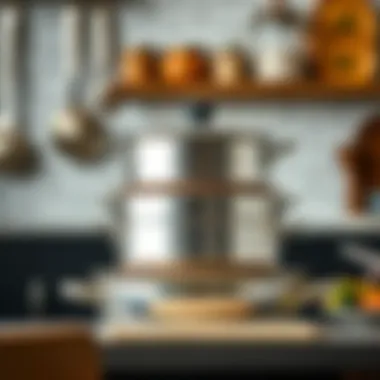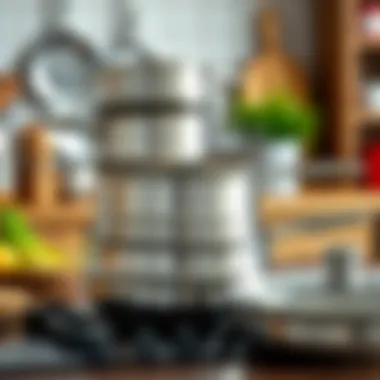Stackable Stainless Steel Cookware: A Complete Guide


Intro
In the world of culinary arts, the tools we choose can make or break the cooking experience. When it comes to pots and pans, stackable stainless steel options are gaining traction. This isn’t just about saving cabinet space, although that’s certainly a perk. The design and functionality of these stackable pots and pans cater to both efficiency and elegance in the kitchen. Homeowners, whether seasoned chefs or weekend warriors, can benefit greatly from understanding these kitchen essentials.
The choice of stainless steel as a material reflects a shift towards durability and easy maintenance. But what makes stackable cookware a worthy investment? This article delves into that question. We’ll explore the design trends, market landscape, and the unique advantages offered by these practical kitchen tools. With the right insights, navigating the myriad of choices within this cookware sector can become a smoother endeavor, helping you find that perfect set that suits your culinary needs.
Design Trends
Current Trends in Stackable Cookware
The modern kitchen is a symphony of style and substance. One trend that stands out among cookware designs is the sleek and functional nature of stackable pots and pans. With an aesthetic that is both contemporary and practical, these pieces often boast clean lines and a polished finish, catering to the tastes of minimalist design lovers.
Additionally, many brands are incorporating multi-functional features into their stackable designs. For example, some pots come with lids that can also serve as frying pans, while others might have interchangeable handles for easy transport. This versatility not only saves space but also enhances the utility of the cookware.
How to Incorporate Trends into Your Kitchen
When adding stackable stainless steel pots and pans to your kitchen, consider how they can complement your existing décor. Here are some ideas:
- Choose sets with a uniform finish: A consistent look can unify your kitchen's design, creating a seamless aesthetic.
- Opt for branded matching lids: Ensuring that lids match your pots and pans not only provides functional storage but also adds a touch of elegance.
- Arrange carefully for easy access: When storing, think about placing frequently used items on top while those used less often remain at the bottom. This keeps your kitchen organized while maintaining the visual appeal.
While integrating these trendy tools, always keep in mind both form and function. Durable yet stylish, stackable stainless steel cookware elevates both the appearance and efficiency of your kitchen space.
Buying Guides
Choosing the Right Cookware
When picking stackable pots and pans, a few key factors should weigh into your decision:
- Capacity: Make sure to choose sizes that fit your cooking habits. A variety allows for flexibility when preparing meals for family or hosting guests.
- Handle design: Look for ergonomically designed handles for comfortable handling, especially when the pots are filled.
- Compatibility: If you use induction cooktops, ensure your chosen cookware works seamlessly with that technology.
Tips for Assessing Quality and Value
No one wants to invest in cookware that doesn’t hold up over time. Here’s what to keep in mind:
- Material Thickness: A thicker material often indicates better heat conduction and durability. Check for at least a 2.5mm thickness in base construction.
- Brand Reputation: Do your homework. Brands like All-Clad and Cuisinart have established themselves as leaders in quality cookware. However, newer brands with promising reviews could offer better value.
- Warranty: A solid warranty can be a marker of quality assurance. Look for brands that stand behind their products.
By focusing on these aspects, the process of selecting the right stackable stainless steel pots and pans can feel less daunting.
"Selecting quality cookware is as critical to a well-functioning kitchen as the ingredients you use; don’t skimp on what you cook with."
As we navigate through the stacks of pots and pans available today, remember that the choices you make should align with your culinary aspirations. Equip yourself with knowledge, and you'll discover that creating a well-organized kitchen isn’t just about aesthetics; it’s about efficient meal preparation and enjoyment.
Foreword to Stackable Cookware
In today's kitchens, every inch of space counts. The art of cooking does not only lie in the recipes or techniques but also in how effectively we utilize our kitchen resources. Stackable pots and pans emerge as a remarkable solution to a perennial problem: storage. They offer not just convenience but the ability to maximize kitchen space, which is especially invaluable for homeowners and design enthusiasts alike.
Defining Stackable Pots and Pans
Stackable pots and pans represent that innovative intersection of functionality and savvy design. Simply put, these are a set of cookware pieces designed to nest perfectly within each other. Imagine this: instead of pots that take up space like a hungry hippo, you have sleek containers that neatly stack up. Choosing such cookware can offer a simpler life in the kitchen, a breath of fresh air in a place that often feels cramped.
The concept behind stackable cookware is straightforward. Each piece is crafted to align seamlessly with others, allowing for a compact storage solution. They are often designed with matching dimensions - think of a Russian doll that hides smaller dolls inside. This not only ensures that they fit conveniently in cabinets but also reduces the clutter that commonly plagues kitchen environments.
Such practicality is essential for the modern chef or weekend cook who desires an organized space. In essence, stackable cookware is like putting your kitchen tools on a health kick – trimming the fat where it’s unnecessary and carving out room for creativity in cooking.
Overview of Stainless Steel Materials
Stainless steel has earned its stripes as a protagonist in the cookware arena. This remarkable material boasts a host of benefits including durability, resistance to rust, and an attractive sheen that can brighten up any kitchen. Understanding the properties of stainless steel helps in appreciating why it is the material of choice for stackable cookware.
Primarily composed of iron, chromium, and a hint of nickel, stainless steel forms a sturdy vessel ideal for cooking. The chromium element forms a protective layer, preventing oxidation and giving pots their shiny finish. Its robust nature allows for both stovetop and oven use, catering to varied cooking styles.
Cooking in stainless steel offers another boon: the non-reactive nature, which means it won’t alter the flavors of your dishes. If you’re simmering a tomato sauce or whisking a delicate cream, rest assured the integrity of your ingredients remains intact.
In addition to functionality, the aesthetic appeal of stainless steel can’t be overlooked. Its polished surface can add a modern flair to your kitchen decor, turning usual cookware into a stylish feature. This blend of utility and elegance explains why stackable pots and pans made from stainless steel are a thought-out choice for any discerning cook.
Advantages of Stackable Pots and Pans
When it comes to kitchen cookware, "stackable" may seem like just a simple term, yet it encapsulates a world of benefits that are particularly significant for anyone serious about cooking or just organizing their kitchen. The advantages of stackable pots and pans stretch far beyond aesthetics. They’re about practicality, efficiency, and optimizing every inch of available space in what can often feel like a cramped culinary environment.
Space Efficiency in Storage


One of the biggest draws of stackable pots and pans is their ability to save invaluable storage space. In the average home kitchen, cabinet and counter space can be at a premium. Stackable cookware can neatly nest within each other, reducing the footprint needed compared to traditional cookware designs. Imagine opening a kitchen cabinet filled to the brim with various pots and pans, only to realize you could fit three or four sets within the same space if they were stackable.
- Maximized Space Usage: By stacking, you can fit more into less space. This allows other kitchen gadgets or a few more dishes to share the limited storage without headache.
- Ease of Access: When pots and pans can be stacked neatly, it reduces the likelihood of digging around to find that elusive lid you need, or having to shift heavy items just to reach for a smaller piece.
- Visual Appeal: Picture this, an orderly cabinet where everything is neatly arranged. Not only does it look good, but it also speaks to efficiency. The eye naturally goes to the items up front without hassle.
Having stackable options translates to an organized kitchen that streamlines cooking tasks.
Organizational Benefits in the Kitchen
Beyond just saving space, stackable pots and pans can also enhance overall kitchen organization. Well-arranged cookware contributes to a more efficient workflow when cooking, allowing for improved access to the necessary tools without any fumbling.
- Clutter Reduction: With stackable cookware, the clutter that accumulates from various unstacked items can be minimized. It creates a semblance of order, which can help mentally ease the chaos that often comes with culinary practices.
- Cohesion of Cookware: Having pieces that are designed to stack means they often come in matching styles or designs. This makes it friendlier for those keen on aesthetic elements in their kitchen.
- Simplified Cleaning and Maintenance: Stacking reduces how many nooks and crannies dust and debris can settle in, simplifying the cleaning process.
Consider how much time you can save by opening a neatly organized cabinet where everything you need is readily visible and accessible. This usability elevates the cooking experience and can foster a more creative atmosphere in culinary experimentation.
"An organized kitchen is the doorway to culinary success. When each tool has its place, inspiration flows seamlessly."
In summary, the advantages of stackable pots and pans are manifold, impacting both space consideration and kitchen organization. Incorporating this kind of cookware into your kitchen routine isn't just about managing space, it’s about creating an environment that enhances your cooking experience.
Benefits of Stainless Steel Cookware
When considering kitchenware, stainless steel cookware stands out for various reasons. Its unique combination of properties makes it a favorite among both amateurs and culinary professionals alike. Understanding these benefits not only enhances your cooking experience but also influences your choices when purchasing stackable pots and pans.
Durability and Longevity
Stainless steel cookware is renowned for its impressive durability. This material resists rust and tarnish, allowing it to maintain its luster for years. Unlike non-stick alternatives, which can scratch and wear down over time, stainless steel offers a robust solution that withstands the rigors of daily cooking. Imagine preparing a hearty stew over high heat on a busy Saturday; the last thing you want is flaky coatings from other materials chipping away. Investing in stainless steel ensures that your cookware remains in great shape even after years of use.
It's worth noting that this longevity translates not only to savings but also minimizes waste. Fewer replacements mean a lighter load on the environment, aligning with sustainable practices. The hefty nature of stainless steel can certainly withstand a fair amount of wear and tear, making it ideal for those who enjoy experimenting in the kitchen.
Heat Distribution and Cooking Performance
One hallmark of stainless steel cookware is its ability to distribute heat evenly. This attribute is essential for precision cooking. Whether you are searing a steak or preparing delicate sauces, even heat distribution provides consistent results. It combats the issue of hotspots common in many cooking surfaces, enabling more effective temperature control. Chefs often emphasize the significance of proper heat when cooking; after all, a meal can be elevated or diminished based on how well the heat is applied.
Moreover, many stainless steel pots and pans come with an aluminum or copper core. This feature enhances conductivity while retaining the stainless steel's durability. As a result, you can quickly get a pot of water boiling or achieve a perfect sear without the need for excessive energy consumption, simplifying your cooking tasks immensely.
Non-Reactive Properties
One of the standout traits of stainless steel cookware is its non-reactive nature. This means it won't interact with acidic or alkaline foods, preserving the flavors and nutritional values of what you are cooking. A rule of thumb in culinary practice is to avoid reactive materials when using ingredients like tomatoes or citrus; otherwise, risk altering the taste or even the color of your dish.
This property also means that you can safely marinate foods in stainless steel without worry. The ability to keep flavors untouched allows creative chefs to experiment freely, conducting science experiments right in their kitchens without concern for corrosion or taste compromise. It's not just about cooking; it's about using a medium that respects the integrity of your ingredients.
For the discerning cook or homeowner, the choice of stainless steel cookware comes with significant advantages that elevate both the cooking process and the final meal. Investing in high-quality stackable options ensures you'll not only have a functional kitchen but one that impresses in every respect.
Considerations When Choosing Stackable Stainless Steel Cookware
When it comes to selecting the right stackable stainless steel cookware, there are several key aspects every buyer should keep in mind. Understanding these considerations can greatly influence not only cooking outcomes but also how effectively you can utilize your kitchen space. Let’s dive deeper into what makes choosing the right stackable pots and pans so crucial.
Assessing Cookware Thickness
The thickness of stainless steel cookware plays a significant role in determining durability and heat retention. Generally, thicker pots and pans provide better heat distribution, reducing the risk of hot spots that can lead to uneven cooking. When looking at options, one should pay attention to the gauge of the steel. A lower gauge number typically means thicker material, which tends to be more robust and long-lasting.
Pros of Thicker Cookware:
- Enhanced Durability: Thicker materials stand up to the wear and tear of everyday cooking much better than thinner alternatives.
- Improved Heat Retention: This can be especially beneficial for slow cooking methods or dishes that require maintaining a consistent temperature.
- Strength Against Warping: Heavy-duty pots are less likely to warp over time, ensuring that your cookware remains flat and functional.
Balancing thickness with the functionality you need is key. While thick stainless steel pots are hardy, they also tend to be heavier and can make cooking tasks more cumbersome.
Evaluating Handles and Lids
Next up to consider are the handles and lids of your cookware. These elements directly impact usability and safety during cooking. The design of the handles should prioritize comfort and grip, especially since you'll be balancing multiple pieces if they're stackable.
Good handles are generally:
- Riveted for Strength: Riveted handles are often more secure than welded ones, providing greater stability when lifting heavy pots.
- Ergonomically Designed: A handle should fit comfortably in your hand, taking the strain out of lifting, even when the pot is hot.
In terms of lids, a well-fitted lid can retain moisture and heat during cooking processes, greatly enhancing the meal outcomes. Look for lids that are tempered glass or metal, as these materials not only provide a good seal but also allow you to see food without needing to lift the lid constantly. Don't overlook the sealing properties; lids should fit snugly to prevent steam from escaping, essential for techniques like steaming and braising.
Compatibility with Cooktops
The final consideration is ensuring that the stackable cookware is compatible with your cooking surfaces. This might sound straightforward, but the reality is that different materials react vastly differently on various cooktops.


Considerations include:
- Induction Compatibility: For those using induction cooktops, ensure that your stainless steel cookware contains magnetic materials. Not all stainless steel is induction-friendly, so verifying specifications is essential.
- Heat Sources: Gas, electric, and ceramic cooktops can each pose different challenges. You may want cookware that distributes heat evenly across the base to avoid concentrated hot spots.
- Oven Safety: If you plan on using the cookware in the oven, check that the handles and lids can withstand high temperatures. Discard those that are made from plastic, as they can melt and deteriorate under high heat.
Maintaining and Caring for Stainless Steel Cookware
The long-lasting appeal of stainless steel cookware is rooted in its ability to withstand the test of time, both in function and aesthetics. However, much like any other valuable possession, proper care and maintenance are pivotal to keeping these kitchen staples in top-notch shape. This section emphasizes not just the 'how' but the 'why' behind maintaining and caring for stainless steel cookware, ensuring that it serves homeowners for years to come.
Cleaning Techniques for Efficacy
Cleaning stainless steel cookware may seem like a simple task, but employing the right techniques ensures its longevity and performance. First and foremost, it’s crucial to use mild detergents instead of harsh chemicals that could scratch or damage the surface. A non-abrasive sponge or cloth also plays a key role in maintaining the finish. Here’s how to tackle cleaning effectively:
- Routine Wash: Start by allowing your pots and pans to cool before washing; drastic temperature changes can warp metal. Upon cooling, soak them in hot soapy water for a few minutes before scrubbing, ensuring that food residues can be easily removed.
- Tough Stains: For food burnt onto the surface, a paste made from baking soda and water can work wonders. Apply it to the affected area and let it sit for about 15 minutes before scrubbing gently. Rinse thoroughly, as any residue can affect cooking.
- Dishwasher Caution: While many stainless steel pots and pans are dishwasher safe, hand washing allows for a gentler clean. Moreover, the high heat in dishwashers can sometimes lead to water spots. If you must use a dishwasher, ensure they’re placed securely to avoid clashes with other utensils.
Preventing Discoloration and Stains
Over time, it’s common for even the finest stainless steel cookware to develop discoloration or stubborn stains. The bright and shiny finish can lose its charm, but this is usually preventable with mindful cooking practices and maintenance. Here are some tried-and-tested strategies:
- Avoid High Heat: Cooking at high temperatures can cause discoloration. For most tasks, medium heat suffices and helps to preserve both flavor and appearance.
- Weekly Maintenance: A simple weekly cleaning routine with a mixture of vinegar and water can inhibit discoloration. Just rinse and dry afterward to keep surfaces unaffected.
- Acidic Foods: Be cautious with acidic ingredients, such as tomatoes or vinegar. They can react with the surface if left in contact for long periods. Always clean pots and pans promptly after such use.
Polishing and Restoring Shine
Even with diligent care, stainless steel cookware can lose its original luster. Luckily, restoring shine isn’t rocket science. The process can be satisfying and, arguably, therapeutic. Consider the following techniques to polish your cookware:
- Plain Vinegar: A simple wipe-down with vinegar can bring about a noticeable shine. For a more comprehensive clean, spray vinegar over the surface, let it sit for a minute, and then wipe with a soft cloth.
- Specialized Cleaners: Manufacturers often recommend their brands for a reason. Products like Bar Keepers Friend are specifically designed for stainless steel. Using these can help maintain that showroom sheen.
- Avoid Abrasives: Though tempting, never use steel wool or abrasive pads – they can create fine scratches that detract from the finish. Instead, choose soft cloths or sponge pads to preserve quality.
Proper maintenance enhances the lifespan of your stackable stainless steel cookware, ensuring it remains not just functional but also beautiful over years of use.
In summary, maintaining and caring for stainless steel cookware is an investment in both performance and aesthetics. By integrating effective cleaning techniques, preventing discoloration, and employing polishing methods, homeowners can ensure their pots and pans remain an integral part of their culinary journey.
Stackable Cookware and Cooking Styles
The ability of stackable cookware to integrate seamlessly with various cooking styles stands as a testament to its versatility and practicality. Nowadays, many cooks, from home chefs to professionals, are searching for pots and pans that not only perform well but also cater to their specific culinary preferences. Stackable stainless steel cookware meets this demand by offering both functionality and space-saving solutions, making it an invaluable addition to any kitchen.
Adaptability for Various Cooking Techniques
Stackable stainless steel pots and pans shine in their ability to adapt to a plethora of cooking techniques. Whether launching a sauté or baking a classic casserole, these pieces can rise to the occasion with ease. For instance, a shallow saucepan can swiftly transition from simmering a broth to browning vegetables, thanks to its even heat distribution and quick responsiveness.
- Boiling: Utilize the larger pots for boiling pasta or blanching vegetables. The stackable design means you can store them without a hassle afterward.
- Sautéing: A wide frying pan that sits nicely on top of smaller pots can manage a stir-fry just as effectively as a gourmet dish requiring precise temperature control.
- Steaming: Stackable cookware may come with lids that convert your regular pot into a steamer, providing a quick method to prepare health-focused meals.
The stacking design does not merely serve a visual aesthetic; it aligns with a more functional approach in which each piece can complement another during diverse culinary adventures. No longer does one need to rummage through layers of awkwardly stored pots to find the right size; these stackable gems simplify that process while enabling creativity.
Suitability for Gourmet Cooking versus Everyday Use
When it comes to the culinary scene, cookware must be both practical for daily meals yet capable of elevating special occasions. Stackable stainless steel cookware achieves this balance adeptly.
For everyday use, the average kitchen demands efficiency. These pots often feature attributes like non-reactivity, ensuring that flavors remain pure while cooking meals like everyday stews or sauces. Furthermore, the ease of cleaning cuts down on post-meal stress, allowing for a quick turnaround between weekday dinners.
However, when the occasion calls for gourmet cooking, the same stackable pots and pans can transform into tools that inspire culinary creativity. They allow chefs to manage multiple elements of a dish simultaneously, such as preparing a sauce in one pan while pan-searing protein in another. The stainless steel surface promotes proper browning, crucial for flavor development in complex recipes.
"Stackable cookware not only saves space but also enriches the user experience by being versatile, allowing chefs to shift seamlessly from everyday meals to gourmet creations."
Thus, whether the goal is crafting a simple meal or impressing with a multi-layered recipe, the versatility of stackable stainless steel pots and pans makes them suitable for both realms of cooking. The unique combination of adaptability and aesthetic makes them a smart investment in any kitchen.
Market Overview of Stainless Steel Stackable Cookware
Understanding the landscape of stainless steel stackable cookware is pivotal for anyone navigating today’s bustling kitchen market. The clarity of choice not only hinges on an array of brands but also on evolving consumer needs and preferences. This section delves into key elements, viewing various offerings through a lens of innovation, market trends, and real-life feedback, setting the stage for informed purchasing decisions.
Leading Brands in the Market
When it comes to stackable stainless steel cookware, several brands stand out, each offering unique features tailored to meet diverse culinary needs. Notable names include:
- Cuisinart: A familiar player in the culinary world, Cuisinart combines quality with versatility—weaving durability into a design that’s meant for everyday use.
- All-Clad: Known for its premium offerings, All-Clad excels in heat conductivity, making its stackable options a favorite among serious cooks.
- Calphalon: With a focus on innovation, Calphalon offers user-friendly designs coupled with efficient stacking capabilities, ideal for space-challenged kitchens.
Ultimately, the right choice often boils down not just to brand reputation but also to specific cooking practices and personal cooking styles. Each brand presents its own set of advantages suited for different culinary adventures.
Emerging Trends and Innovations
As the market for stackable cookware evolves, several trends are taking shape that reflect both lifestyle changes and advancements in technology:


- Sustainable Materials: More consumers are gravitating toward eco-friendly options. Brands are now embracing recycled stainless steel, contributing to the environmental conversation.
- Enhanced Compatibility: Today's designs focus on seamless interactions with induction cooktops and modern heat sources, accommodating a wider array of cooking scenarios.
- Smart Features: Interestingly, smart technology is slowly making its way into cookware—think sensors that indicate when your pot is at the ideal temperature or apps that provide recipe suggestions based on the equipment you own!
These innovations underscore a shift where convenience and sustainability are paramount, aligning with the preferences of eco-conscious and tech-savvy cooks alike.
Consumer Preferences and Feedback
Real-world user experiences often reveal what’s truly valuable in the kitchen. Feedback on stainless steel stackable cookware manifests in various themes:
- Space-Saving: Many users applaud stackable designs for their practical storage solutions, ingeniously fitting into modern, often compact kitchens.
- Performance: The consistent heat distribution of stainless steel is frequently cited as a major advantage, allowing cooks to master delicate dishes or bold sears with equal finesse.
- Weight Considerations: While durability is cherished, some consumers wish for a balance between sturdiness and manageability, noting that excessively heavy pieces can be cumbersome during meal prep.
“Stackable pots are a revelation in my small kitchen; it’s like discovering a whole new world of space!” —A satisfied home cook
Through all these insights, the reader gains a clearer picture of not only the products available but also the lived experiences that shape purchasing decisions—a critical viewpoint for both manufacturers and consumers alike.
Comparison with Other Cookware Materials
When exploring the world of cookware, comparing materials becomes essential, especially to choose the right utensils for your kitchen. Among various options available, stackable pots and pans made from stainless steel stand out, but how do they fare against other materials like non-stick and cast iron? Understanding these differences helps homeowners, designers, retailers, and culinary enthusiasts make informed decisions that best suit their cooking styles and needs.
Stainless Steel versus Non-Stick
Stainless steel pots and pans have their own distinct advantages when put side by side with non-stick options. While non-stick cookware is renowned for its ease of use—food slides out effortlessly, making cleanup a breeze—this convenience comes at a cost. Typically, non-stick coatings can wear off over time, leading to potential leaching of harmful substances if not properly maintained. Here are some key points in this comparison:
- Durability: Stainless steel is significantly more durable than non-stick materials. It can withstand higher temperatures and is less prone to scratching.
- Cooking Techniques: Unlike non-stick cookware, stainless steel excels in browning and creating fond, which forms the basis for many flavorful sauces and dishes. This enhances versatility in culinary explorations.
- Health Considerations: Stainless steel is a metal that does not release any chemicals into food, making it a safer choice for those wary of non-stick materials that may contain PFOA or PTFE.
- Maintenance: While cleaning stainless steel may require a bit more elbow grease, many regard the long-term benefits of durability as worth the effort.
In short, if you enjoy roasting, searing, or simply appreciate the robust feel of enduring cookware, stainless steel provides substantial advantages over non-stick options, making it a stellar choice in a stackable design.
Stainless Steel versus Cast Iron
Cast iron cookware has been a staple in kitchens for generations. Like stainless steel, it boasts several unique qualities, but it also has a few notable flaws. To dissect the two, one must contemplate the following:
- Heat Retention: Cast iron retains heat exceptionally well, making it ideal for slow cooking and frying. However, minimizing weight can be challenging, especially for stackable pots and pans that many seek for practicality.
- Seasoning Needs: Unlike stainless steel, cast iron requires regular seasoning to maintain its non-stick quality, which might be inconvenient for some. Stainless steel, on the other hand, offers consistently straight-up cooking performance without the need for such maintenance tasks.
- Versatility: While cast iron can be placed directly in the oven, not all stainless steel cookware is oven-safe. Thus, homeowners need to inspect the specifications closely.
- Weight and Handling: Stainless steel is often lighter than cast iron, which makes for easier handling and stacking without the risk of damage— particularly for those who might not have the muscle power for heavier items.
"Choosing the right cookware depends more on the cooking style and the personal preferences of the user rather than a blanket endorsement of one material over another."
By contemplating these comparisons, you can better understand your cooking habits and make choices that resonate with your culinary journey.
User Experiences with Stackable Stainless Steel Cookware
User experiences provide a lens through which potential buyers can gauge the effectiveness and practicality of stackable stainless steel cookware. This section holds significance not only as a review platform but also as a reflection of the real-world performance of these kitchen essentials. It's one thing to read about a product's features, but hearing from those who have actually used them paints a clearer picture of what one can expect. Through analyzing user experiences, we uncover the practical benefits, elements of satisfaction, and considerations to be mindful of when incorporating stackable stainless steel cookware into everyday culinary practices.
Positive Reviews and Common Praises
Feedback from users often highlights several key areas where stackable stainless steel cookware excels:
- Space-Saving Design: Many individuals rave about how these pots and pans fit neatly into cupboards, allowing for more efficient use of kitchen space. When cooking enthusiasts share their stories about transforming cluttered cabinets into organized havens, it often sparks the interest of those grappling with storage issues.
- Durability: Users frequently mention the rugged nature of stainless steel. Reviews cite longevity—pans that withstand scratches and resist warping even under intense cooking conditions. The consensus that comes from various testimonials feels almost unanimous: stainless steel is built to last.
- Versatility in Cooking: Many users appreciate that these cookware pieces often transition smoothly from stovetop to oven, broadening culinary horizons. Whether sautéing vegetables or baking lasagna, the ability to cook with one piece of cookware tends to be a common commendation.
- Easy to Clean: Users tend to point out the non-porous surface of stainless steel, which helps in keeping the cookware clean. Many find that a simple soak and wipe, or a run through the dishwasher, is often enough to restore shine and cleanliness. A handful of testimonials note that even tough stains can be tackled with a bit of baking soda, turning cleaning into an uncomplicated task.
The sentiments echoed in user reviews often align closely with these observations, signifying a high level of satisfaction with stackable stainless steel cookware.
"I never realized how much space could be freed up in my kitchen until I switched to stackable cookware. It's like I have a whole new kitchen!"
Challenges Faced by Users
While the praises are abundant, it’s important to address the challenges that some users encounter. Awareness of these aspects can assist potential buyers in making informed decisions:
- Weight Considerations: A notable portion of users mentioned that while the quality comes with weight, it can sometimes be cumbersome. Those with limited upper body strength may find heavier pots difficult to manage.
- Heat Conductivity Issues: A few users noted that certain pots may heat unevenly at times. This can lead to minor frustrations such as burning food if not monitored closely—especially when multitasking during meal prep.
- Price Point: Some consumers wrestle with the up-front cost associated with high-quality stackable stainless steel cookware. While touted for longevity, the initial investment can deter budget-conscious shoppers who might favor cheaper alternatives. Feedback here often highlights the adage "you get what you pay for," but it also brings to light the hesitation some feel before committing to a more costly purchase.
- Cleaning Challenges with Discoloration: Although many spoke positively about cleaning, others have experienced discoloration from high heat or acidic foods. Though it doesn’t affect cooking performance, aesthetics can become an issue for some.
Understanding both the high points and the pitfalls of user experiences creates a balanced perspective for anyone considering stackable stainless steel cookware. It’s a marriage of pros and cons that sets the stage for optimizing cooking endeavors in both functional and aesthetic terms.
Closure and Final Thoughts
In wrapping up this detailed exploration of stackable pots and pans in stainless steel, it becomes evident that these cooking essentials are not just a trend but a practical solution for culinary enthusiasts and everyday cooks alike. Stackable cookware offers a remarkable blend of functionality and style, creating an inviting environment in kitchens that often teem with clutter.
One of the most significant elements discussed is the space efficiency stackable cookware brings. In homes where kitchen real estate is at a premium, these pots and pans reduce chaos, allowing for streamlined storage. Coupled with the organizational benefits, visually appealing stacking can make your cooking space not only tidy but also conducive to creativity and productivity.
Recap of Key Points
To recap key points:
- Space Efficiency and Organization: Stackable designs help conserve space and improve kitchen organization.
- Material Benefits: Stainless steel enhances durability, heat distribution, and non-reactive cooking, all pivotal in achieving culinary excellence.
- Market Overview: Knowledge of prominent brands and emerging trends helps consumers make informed decisions, ensuring they choose cookware that meets their needs.
- User Experiences: Understanding both positive feedback and challenges allows potential buyers to set realistic expectations.
These aspects play a crucial role for homeowners, designers, and DIYers, providing them with the knowledge base necessary to make choices that can affect both the aesthetic and functional quality of their kitchens.
Future Outlook for Stackable Cookware
Looking ahead, the future for stackable stainless steel cookware appears bright. As kitchens evolve to become multi-functional spaces, the demand for innovative and adaptable cookware is likely to grow. Expect to see:
- Increased Customization: Brands might introduce modular designs that allow users to mix and match pots and pans, tailoring their kitchenware to their unique cooking styles.
- Sustainability Trends: With rising focus on eco-friendliness, more manufacturers could explore sustainable materials and manufacturing processes.
- Technological Innovations: Smart features, such as temperature sensors or non-slip stacking solutions, might become commonplace, enhancing user experience further.















